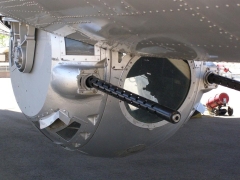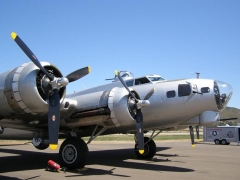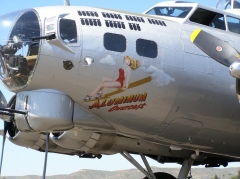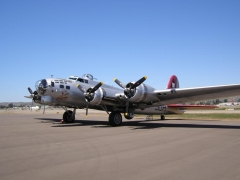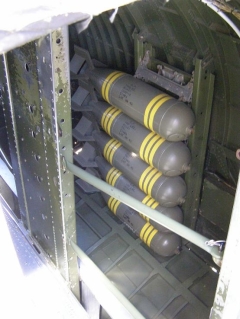EAA B-17 ROAMS THE WEST
Story and Photos © by Frank Lorey III
“Aluminum Overcast”, the Experimental Aircraft Association’s restored B-17G Flying Fortress, stopped at several Southern California airports as part of the 2009 national tour. The popular World War II bomber has participated in tours across the U.S. since 1994, as well as being featured at the EAA annual AirVenture fly-in each summer in Oshkosh, Wisconsin.
At
each stop, the plane is open for ground tours, as well as offering opportunities
for flights. The EAA sees this as
an opportunity to preserve the spirit of World War II aviation, and to help
people learn about one of the most famous aircraft in military history.
Information on future tours and the opportunity to participate is available
at www.b17.org, the EAA site dedicated to the
plane. Six crewmen are with the plane
on the tour—two pilots, two mechanics, and two “tour coordinators” who drive
the two truck/trailer combos that support each stop.
Aluminum
Overcast was built in 1945, but near the end of the war in Europe so it never
saw action. After the war, it was
declared obsolete and placed in storage in the United States until it was
sold as war surplus for only $750. Today
the aircraft would be worth millions.
Once
it was in private hands, the Flying Fortress served a number of uses—a platform
for aerial mapping, pest control spraying, cargo hauling, forestry work, etc.--until
a restoration group purchased it in 1978. Several years of work went into the aircraft in an attempt to restore
it to its World War II glory days, but the effort grew too much for those
individuals, so it was donated to the EAA in 1983. It took another ten years to complete the work
and get the plane back in the air.
The
biggest problems in returning the B-17 to wartime specifications was replacing
a Norden Bombsight in the nose, creating the gunner positions in the waist,
tail, and top turret, creating the navigator’s station, and rebuilding a radioman’s
compartment. All of the original type
equipment had to be located and placed back in the aircraft. Even the flooring had to be rebuilt as it would
have been in 1945. A few things remain
to be completed, but the aircraft is remarkably back to the original World
War II authentic configuration in most details. Even things not usually noticed, such as the armor plating, have
been restored.
The
B-17G is maintained in the color scheme of the 398th Bomb Group.
The “G” model was the most numerous produced during the war—roughly
2/3rds of the 12,000 built, and carried thirteen .50-caliber machine
guns, in addition to the 4-ton bomb load, truly a “Flying Fortress.”
It usually carried a crew of nine or ten.
The original “Aluminum Overcast” was shot down on its 34th
combat mission, over Le Manior, France, in 1944.
Only
about 60 Flying Fortresses remain today, most as static museum displays. Approximately a dozen are still able to take
to the air. At each stop along the
tour, one or two veterans who flew in B-17’s are present to tell of their
experiences.
Wilbur
Richardson enlisted in February 1943, and was trained as a radioman and gunner.
Just before going overseas, he was shifted in the crew position to
the ball turret, not an enviable job. Once they got to England, in April 1944, they
got the news that their 25-mission tour had been already extended to 30 missions.
Richardson
said “It only took me 79 days to get in 30 missions, and of those, four or
five really stood out.” His first
mission was “an eye-opener. It was
the first time you see flak, first time you see a plane go down, and you know
they mean business. His second and
third missions were done in one day, a feat not accomplished again until D-Day.
In
May, he was on a 370-plane raid into Czechoslovakia where they lost 47 aircraft.
Richardson recalled “We were told we didn’t have escort, we missed
it for some reason. There were over 400 enemy fighters up, and
only 5 or 6 P-51’s. I saw a Me-109
and P-51 head on into each other, nose to nose.
Those guys kept coming into us; it was constant all the way into the
target. Almost all the planes got
hit; we lost an engine and took a hit in the elevator. I did manage to shoot down two planes that day.”
Another
memorable mission was dropping supplies to the French underground resistance
fighters. After the war, Richardson
got to meet some of them. He also
remembered his 30th mission, not just because it was his last,
but because he was wounded on it.
Frank
Sexton was also trained as a radioman and gunner when he enlisted in January
1942. He was stationed in Ridgwell,
England, but not for long. He was
shot down on his third mission, and spent the rest of the war in Stalag Luft
17B, a notorious prisoner of war camp.
Sexton
recalled “We were almost to Poland when we were shot down, but we sere still
over Germany. I had to parachute,
and civilians came after me, but I hid in some brush. I thought I could get away, but I was wrong.”
He
added “We were really treated badly—the interrogation center was really bad,
and in the regular prison they would bang you around, and there was the cold
and hunger. I weighed about 170 when
I was shot down, and was only 90 something after eating for a couple of days
after I had been liberated. I got
sick as a dog eating bread then.”
Even
if you do not sign up to fly in “Aluminum Overcast”, the aircraft interior
tour and the opportunity to visit with veterans are well worth your time!


